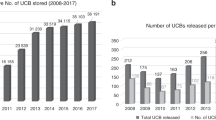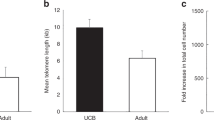Abstract
As the history of the cord blood banking system has lengthened, the number of cord blood units (CBUs) cryopreserved for years has increased. The global expansion of cord blood banking resulted in active international exchange of CBUs. To determine whether long-term cryopreservation and international shipment of CBUs affect the quality of the units and outcome after transplantation, we retrospectively analyzed the quality of 95 CBUs and the hematologic recovery of 127 patients with hematological malignancy following single-unit cord blood transplantation. Of the 127 CBUs used to transplant, 42 units were cryopreserved for long periods (5–11.8 years), and 44 units were shipped from distant countries. We found that length of cryopreservation and origin of CBUs did not affect the ratio of viable total-nucleated cells after thawing. Also, neutrophil engraftment was not affected by long-term cryopreservation (> 5 years) or origin (from distant countries), (hazard ratio, 0.91 and 1.2; P=0.65 and 0.41; respectively). The number of CD34+ cells before freezing (> 1.4 cells/kg recipient) was the only factor that enhanced neutrophil engraftment (hazard ratio, 1.8; P<0.01). This suggests that length of cryopreservation and origin need not be prioritized over the CD34+ cell dose when selecting CBUs.
This is a preview of subscription content, access via your institution
Access options
Subscribe to this journal
Receive 12 print issues and online access
$259.00 per year
only $21.58 per issue
Buy this article
- Purchase on Springer Link
- Instant access to full article PDF
Prices may be subject to local taxes which are calculated during checkout


Similar content being viewed by others
References
Rocha V, Labopin M, Sanz G, Arcese W, Schwerdtfeger R, Bosi A et al. Transplants of umbilical-cord blood or bone marrow from unrelated donors in adults with acute leukemia. N Engl J Med 2004; 351: 2276–2285.
Laughlin MJ, Eapen M, Rubinstein P, Wagner JE, Zhang MJ, Champlin RE et al. Outcomes after transplantation of cord blood or bone marrow from unrelated donors in adults with leukemia. N Engl J Med 2004; 351: 2265–2275.
Eapen M, Rubinstein P, Zhang MJ, Stevens C, Kurtzberg J, Scaradavou A et al. Outcomes of transplantation of unrelated donor umbilical cord blood and bone marrow in children with acute leukaemia: a comparison study. Lancet 2007; 369: 1947–1954.
Querol S, Gomez SG, Pagliuca A, Torrabadella M, Madrigal JA . Quality rather than quantity: the cord blood bank dilemma. Bone Marrow Transplant 2010; 45: 970–978.
Welte K, Foeken L, Gluckman E, Navarrete C, Association CBWGotWMD. International exchange of cord blood units: the registry aspects. Bone Marrow Transplant 2010; 45: 825–831.
Broxmeyer HE, Srour EF, Hangoc G, Cooper S, Anderson SA, Bodine DM . High-efficiency recovery of functional hematopoietic progenitor and stem cells from human cord blood cryopreserved for 15 years. Proc Natl Acad Sci USA 2003; 100: 645–650.
Broxmeyer HE, Lee MR, Hangoc G, Cooper S, Prasain N, Kim YJ et al. Hematopoietic stem/progenitor cells, generation of induced pluripotent stem cells, and isolation of endothelial progenitors from 21- to 23.5-year cryopreserved cord blood. Blood 2011; 117: 4773–4777.
Foundation for the Accreditation of Cellular Therapy (FACT), International Netcord Foundation. NetCord-FACT International Standards for Cord Blood Collection, Banking, and Release for Administration. 5th ed. 2013. Available at www.factweb.org.
Barker JN, Byam C, Scaradavou A . How I treat: the selection and acquisition of unrelated cord blood grafts. Blood 2011; 117: 2332–2339.
Rubinstein P, Dobrila L, Rosenfield RE, Adamson JW, Migliaccio G, Migliaccio AR et al. Processing and cryopreservation of placental/umbilical cord blood for unrelated bone marrow reconstitution. Proc Natl Acad Sci USA 1995; 92: 10119–10122.
Sutherland DR, Anderson L, Keeney M, Nayar R, Chin-Yee I . The ISHAGE guidelines for CD34+ cell determination by flow cytometry. International Society of Hematotherapy and Graft Engineering. J Hematother 1996; 5: 213–226.
Lin DY . Non-parametric inference for cumulative incidence functions in competing risks studies. Stat Med 1997; 16: 901–910.
Kanda Y . Investigation of the freely available easy-to-use software 'EZR' for medical statistics. Bone Marrow Transplant 2013; 48: 452–458.
Wall DA . Regulatory issues in cord blood banking and transplantation. Best Pract Res Clin Haematol 2010; 23: 171–177.
McCullough J, McKenna D, Kadidlo D, Schierman T, Wagner J . Issues in the quality of umbilical cord blood stem cells for transplantation. Transfusion 2005; 45: 832–841.
Scaradavou A, Smith KM, Hawke R, Schaible A, Abboud M, Kernan NA et al. Cord blood units with low CD34+ cell viability have a low probability of engraftment after double unit transplantation. Biol Blood Marrow Transplant 2010; 16: 500–508.
Wagner JE, Barker JN, DeFor TE, Baker KS, Blazar BR, Eide C et al. Transplantation of unrelated donor umbilical cord blood in 102 patients with malignant and nonmalignant diseases: influence of CD34 cell dose and HLA disparity on treatment-related mortality and survival. Blood 2002; 100: 1611–1618.
Rodrigues CA, Sanz G, Brunstein CG, Sanz J, Wagner JE, Renaud M et al. Analysis of risk factors for outcomes after unrelated cord blood transplantation in adults with lymphoid malignancies: a study by the Eurocord-Netcord and lymphoma working party of the European group for blood and marrow transplantation. J Clin Oncol 2009; 27: 256–263.
Mugishima H, Harada K, Chin M, Suzuki T, Takagi K, Hayakawa S et al. Effects of long-term cryopreservation on hematopoietic progenitor cells in umbilical cord blood. Bone Marrow Transplant 1999; 23: 395–396.
Kudo Y, Minegishi M, Seki O, Takahashi H, Suzuki A, Narita A et al. Quality assessment of umbilical cord blood units at the time of transplantation. Int J Hematol 2011; 93: 645–651.
Goodwin HS, Grunzinger LM, Regan DM, McCormick KA, Johnson CE, Oliver DA et al. Long term cryostorage of UC blood units: ability of the integral segment to confirm both identity and hematopoietic potential. Cytotherapy 2003; 5: 80–86.
Jubert C, Wagner E, Bizier S, Vachon MF, Duval M, Champagne MA . Length of cord blood unit cryopreservation does not impact hematopoietic engraftment. Transfusion 2008; 48: 2028–2030.
Frassoni F, Gualandi F, Podestà M, Raiola AM, Ibatici A, Piaggio G et al. Direct intrabone transplant of unrelated cord-blood cells in acute leukaemia: a phase I/II study. Lancet Oncol 2008; 9: 831–839.
Acknowledgements
This study was supported by a grant from the European Hematology Association—Japanese Society of Hematology Fellowship Exchange Award in 2011. We thank Dr M Gosho (CREIL Center, University of Tsukuba) for statistical advice, and Brian K. Purdue (Medical English Communications Center, University of Tsukuba) for grammatical review and advice. This study was supported by a grant from the European Hematology Association—Japanese Society of Hematology Fellowship Exchange Award in 2011.
Author information
Authors and Affiliations
Corresponding author
Ethics declarations
Competing interests
The authors declare no conflict of interest.
Rights and permissions
About this article
Cite this article
Kurita, N., Frassoni, F., Chiba, S. et al. Impact of length of cryopreservation and origin of cord blood units on hematologic recovery following cord blood transplantation. Bone Marrow Transplant 50, 818–821 (2015). https://doi.org/10.1038/bmt.2015.56
Received:
Revised:
Accepted:
Published:
Issue Date:
DOI: https://doi.org/10.1038/bmt.2015.56



